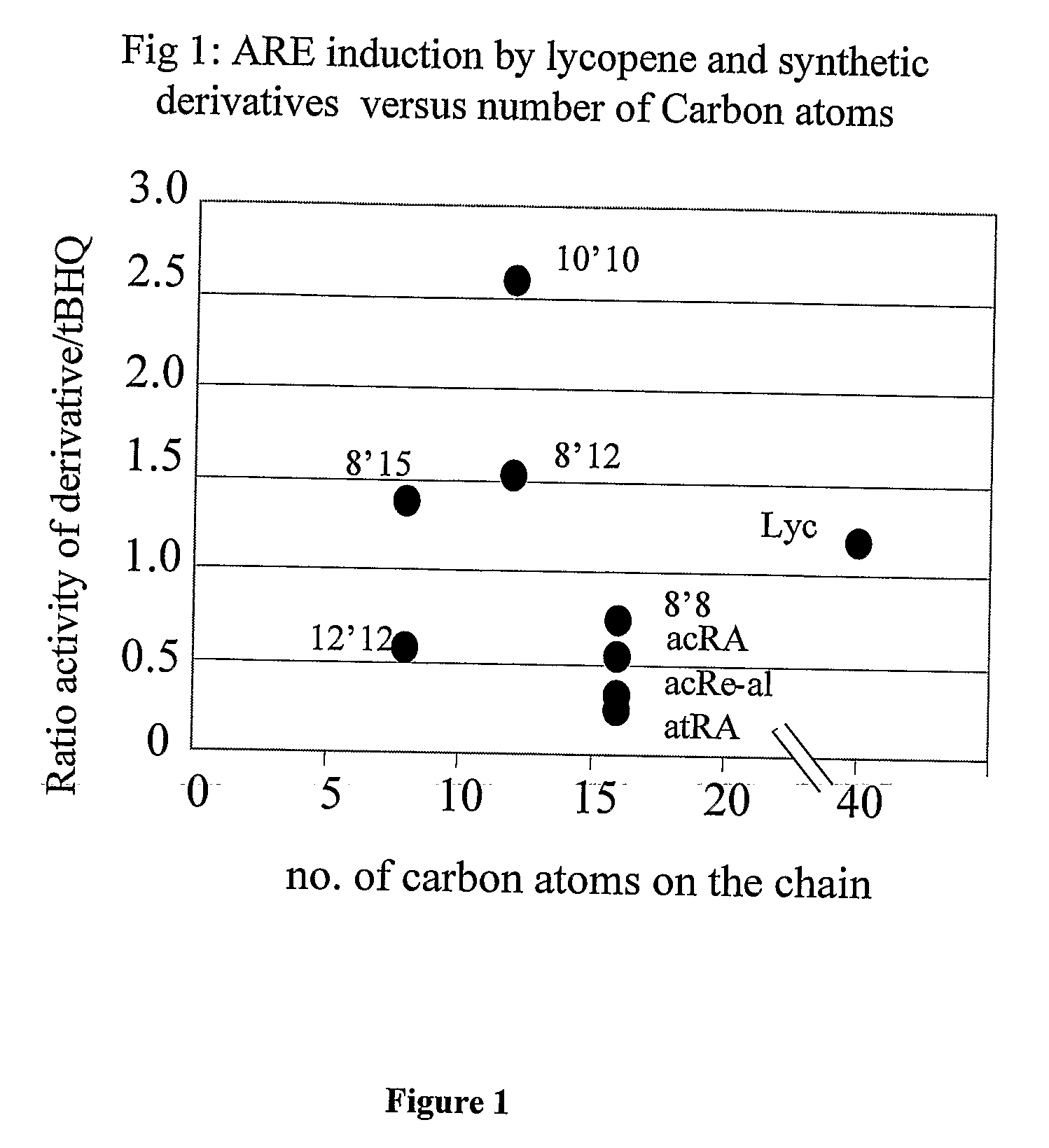Carotenoid oxidation products as chemopreventive and chemotherapeutic agents
- Summary
- Abstract
- Description
- Claims
- Application Information
AI Technical Summary
Benefits of technology
Problems solved by technology
Method used
Image
Examples
example 1
ARE Induction by Lycopene Derivatives
[0097]The effects of lycopene and several lycopene derivatives on antioxidant response element (ARE) induction were tested in all of the cancer cell lines mentioned above. The assay employed measures the transcriptional activity of the antioxidant response element which is activated by the Nrf2 transcription factor, and its activation by carotenoids and their derivatives. Parts of a promoter of the genes of interest were fused to a luciferase reporter gene as described in Materials and Methods. The constructs were transfected into the cells. Cells were incubated with carotenoids or derivatives and activation of transcription was measured.
[0098]The following synthetic lycopene derivatives were used: a) diapo-8,8′-lycopendial (8,8′); b) diapo-8′,12-lycopendial (8′,12); c) diapo-10,10′-lycopendial (10,10′); d) diapo-12,12′-lycopendial (12,12′); and e) diapo-8′,15-lycopendial (8′,15).
[0099]The results are depicted in FIG. 1 as the mean of 3-6 experim...
example 2
Effect of Lycopene Derivatives on Mammary Cancer Cell Proliferation
[0102]The effect of lycopene, atRA and several lycopene derivatives ((a) diapo-8,8′-lycopendial; (b) diapo-8′,12-lycopendial; (c) diapo-10,10′-lycopendial; (d) diapo-12,12′-lycopendial; and (e) diapo-8′,15-lycopendial) on cell proliferation and ARE induction in two human breast cell lines (MCF-7 and T47D) was examined.
[0103]FIG. 2A shows the effect of several lycopene derivatives on ARE induction, and FIG. 2B shows the corresponding effect on cellular proliferation. As shown, mammary cancer cell proliferation was differentially inhibited by several synthetic dialdehyde lycopene derivatives.
[0104]The results further show that there is a significant correlation between the activation of ARE (FIG. 2A) and inhibition of cell proliferation (FIG. 2B). For example, the 10′10 derivative was more active than lycopene in both ARE induction and inhibition of cell proliferation, whereas the 8′8 derivative was less active in both...
example 3
Effect of Lycopene Derivatives on Prostate Cancer Cell Proliferation
[0105]The effect of lycopene, atRA and several lycopene derivatives ((a) diapo-8,8′-lycopendial; (b) diapo-8′,12-lycopendial; (c) diapo-10,10′-lycopendial; (d) diapo-12,12′-lycopendial; and (e) diapo-8′,15-lycopendial) on cell proliferation and ARE induction in a LNCaP prostate cancer cell line was examined. As shown in FIG. 3, prostate cancer cell proliferation is also inhibited by these derivatives in a differential manner, demonstrating the ability of these derivatives to inhibit the proliferation of a wide range of cancer cells.
[0106]The results presented herein demonstrate that derivatives of lycopene, which are putative lycopene oxidation products, are potent inhibitors of cancer cell proliferation, and are thus useful agents for the treatment and prevention of cancer.
PUM
| Property | Measurement | Unit |
|---|---|---|
| Fraction | aaaaa | aaaaa |
| Cell proliferation rate | aaaaa | aaaaa |
| Antioxidant | aaaaa | aaaaa |
Abstract
Description
Claims
Application Information
 Login to View More
Login to View More - R&D
- Intellectual Property
- Life Sciences
- Materials
- Tech Scout
- Unparalleled Data Quality
- Higher Quality Content
- 60% Fewer Hallucinations
Browse by: Latest US Patents, China's latest patents, Technical Efficacy Thesaurus, Application Domain, Technology Topic, Popular Technical Reports.
© 2025 PatSnap. All rights reserved.Legal|Privacy policy|Modern Slavery Act Transparency Statement|Sitemap|About US| Contact US: help@patsnap.com



